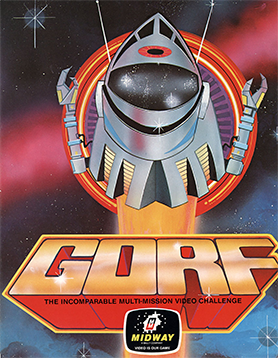
Gorf is an arcade video game released in 1981 by Midway Manufacturing, whose name was advertised as an acronym for "Galactic Orbiting Robot Force". It is a fixed shooter with five distinct levels, the first of which is based on Space Invaders and another on Galaxian. The game makes heavy use of synthesized speech for the Gorfian robot which taunts the player, powered by the Votrax speech chip. Gorf allows the player to buy two additional lives per quarter before starting the game, for a maximum of seven lives.

Spy vs. Spy is a video game written by Michael Riedel for the Commodore 64 and published by First Star Software in 1984. A port for the Atari 8-bit computers was released simultaneously. It is a two-player, split-screen game, based on Mad magazine's long-running cartoon strip Spy vs. Spy, about the slapstick antics of two spies trying to kill each other with improbably elaborate traps and weapons.

Star Goose is a vertically scrolling shooter that was published for the Amiga, Atari ST, and MS-DOS by Logotron in 1988. The player controls Scouser-Gitt, who pilots the eponymous Star Goose, a vessel that has been commissioned to scour the planet Nom and collect 48 crystals. Players must collect all six crystals in each of the game's eight levels to advance, while at the same time avoiding or destroying enemies and maintaining their shield, ammunition, and fuel levels. The game's surfaces are contoured, which affects the way that bullets travel, and contain tunnels that switch modes to a three-dimensional perspective where the player can replenish their resources.
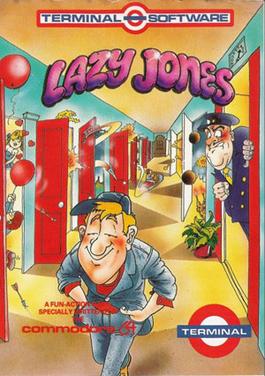
Lazy Jones is a platform game for the Commodore 64, ZX Spectrum, MSX and Tatung Einstein. It was written by David Whittaker and released by Terminal Software in 1984. The Spectrum version was ported by Simon Cobb.
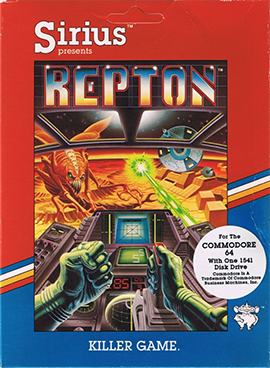
Repton is a Defender-inspired scrolling shooter written by Dan Thompson and Andy Kaluzniacki for the Apple II and published by Sirius Software in 1983. It was ported to the Atari 8-bit computers, and Commodore 64.

Crossfire is a multidirectional shooter created by Jay Sullivan for the Apple II and published by On-Line Systems in 1981. Using keyboard-based twin-stick shooter controls, the player maneuvers a ship in a grid-like maze. Versions with joystick-control use the stick for movement and switch to firing mode when the button is held down.
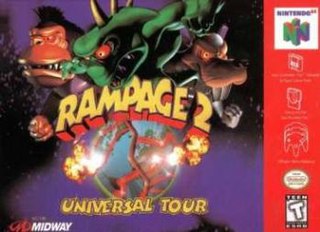
Rampage 2: Universal Tour is a 1999 action game developed by Avalanche Software and published by Midway. It is the third game in the Rampage series and a sequel to 1997's Rampage World Tour.

Blue Max is a scrolling shooter written by Bob Polin for Atari 8-bit computers and published by Synapse Software in 1983. It was released for the Commodore 64 the same year. U.S. Gold published the Commodore 64 version in the UK in 1984 and ported the game to the ZX Spectrum. In 1987, Atari Corporation published Blue Max as a cartridge styled for the then-new Atari XEGS.

Gateway to Apshai is an action-adventure game for the Commodore 64, ColecoVision and Atari 8-bit computers. It was developed by The Connelley Group and published by Epyx in 1983 as a prequel to Temple of Apshai. It is a more action-oriented version of Temple of Apshai, with smoother and faster graphics, streamlined controls, fewer role-playing video game elements, and fewer room descriptions.

Arcadia is a fixed shooter published by Imagine Software for the ZX Spectrum and VIC-20 in 1983. It was later ported to the Commodore 64 and Dragon 32.

Dropzone is a horizontally scrolling shooter developed by Archer Maclean for Atari 8-bit computers and published in 1984 by U.S. Gold. It was ported to the Commodore 64, and later released for the Nintendo Entertainment System, Game Boy, Game Gear, and Game Boy Color.

Space Gun is a 1990 first-person shooter arcade game released by Taito. The game is set aboard a crippled space station that has been overrun by hostile alien creatures. The objective is to rescue human crew members while destroying the alien creatures. The game lets the player shoot limbs off the creatures, resulting in blood splatters.

Cops 'n' Robbers is a video game published by Atlantis Software in 1985 for the VIC-20 and in virtually identical form on the Commodore 64. It was ported to the Commodore 16 and Commodore Plus/4 (1986), Acorn Electron and BBC Micro (1987), and Atari 8-bit computers (1988). The game was controversial when released as the player takes the role of a robber and must shoot the police.

Sheep in Space is a video game written by Jeff Minter for the Commodore 64 and published in 1984 by Llamasoft. It is a horizontally scrolling shooter which borrows gameplay from Defender re-themed to involve sheep. The title screen features an arrangement of Bach's "Sheep May Safely Graze" by pianist James Lisney.
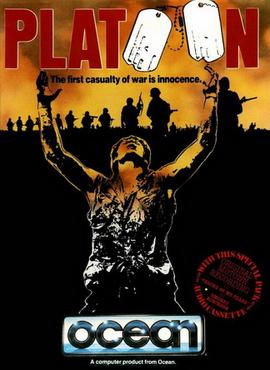
Platoon is an action game developed by Ocean Software and published by Data East for the Amiga, Amstrad CPC, Apple II, Atari ST, Commodore 64, PC DOS and ZX Spectrum in 1987–1988. The NES version was ported and published by Sunsoft in September 1988. It was the first video game adaptation of the 1986 war film Platoon, followed by the 2002 game.

Death or Glory is a multidirectional scrolling shooter developed by Wise Owl Software and published by CRL Group in 1987 for the Commodore 64, ZX Spectrum, and Amstrad CPC. The player pilots a space ship and encounters an alien invasion that they then have to defeat. The game received average to negative reviews.

Bandits is a 1982 fixed shooter written by Tony and Benny Ngo for the Apple II and published by Sirius Software. The game is a clone of Taito's 1980 Stratovox arcade video game where the goal is to prevent aliens from stealing objects. Bandits was ported to the Atari 8-bit computers, Commodore 64, and VIC-20.

Ghostbusters II is a 1989 action game based on the film of the same name. It was published by Activision for various computer platforms. British studio Foursfield developed a version for Commodore 64, Amiga, Atari ST, Amstrad CPC and ZX Spectrum, which also got ported to the MSX by New Frontier. It features three levels based on scenes from the film. Dynamix developed a separate version for the DOS, also based on the film. The non-DOS versions were praised for the graphics and audio, but criticized for long loading times, disk swapping, and the final level. The DOS, Commodore 64 and Amiga versions were the only versions released in North America.

Protector II is a video game written by Mike Potter for Atari 8-bit computers and published by Synapse Software in 1982. It is a sequel to 1981's Protector; both games are horizontally scrolling shooters inspired by the arcade video game Defender. Protector II was ported to the Commodore 64, TI-99/4A, and TRS-80 Color Computer.

Threshold is a space-themed fixed shooter written by Warren Schwader and Ken Williams for the Apple II and published by On-Line Systems in 1981. Inspired by Sega's Astro Blaster arcade video game, Threshold introduces many enemy ship types and wave formations as the game progresses. Reviewers found the variety distinguished the game from the many similar shoot 'em ups.





















